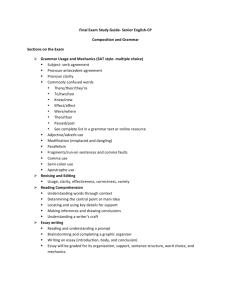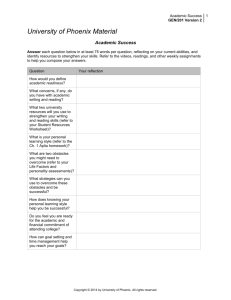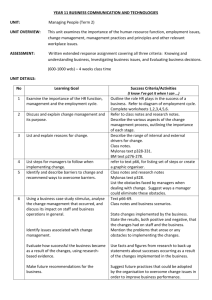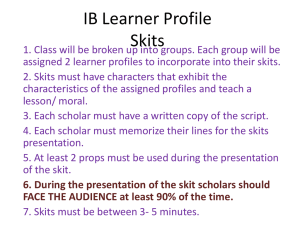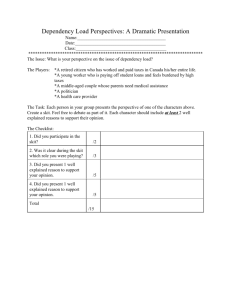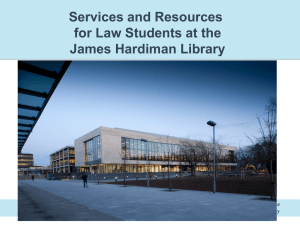brain-targeted teaching learning unit
advertisement
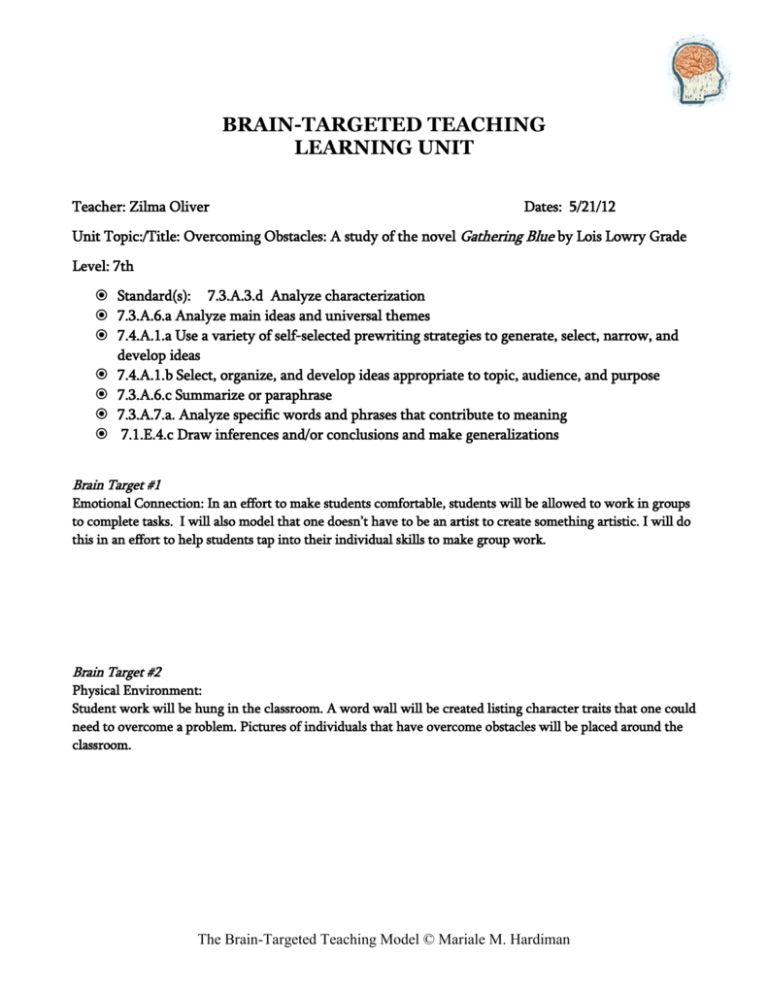
BRAIN-TARGETED TEACHING LEARNING UNIT Teacher: Zilma Oliver Dates: 5/21/12 Unit Topic:/Title: Overcoming Obstacles: A study of the novel Gathering Blue by Lois Lowry Grade Level: 7th Standard(s): 7.3.A.3.d Analyze characterization 7.3.A.6.a Analyze main ideas and universal themes 7.4.A.1.a Use a variety of self-selected prewriting strategies to generate, select, narrow, and develop ideas 7.4.A.1.b Select, organize, and develop ideas appropriate to topic, audience, and purpose 7.3.A.6.c Summarize or paraphrase 7.3.A.7.a. Analyze specific words and phrases that contribute to meaning 7.1.E.4.c Draw inferences and/or conclusions and make generalizations Brain Target #1 Emotional Connection: In an effort to make students comfortable, students will be allowed to work in groups to complete tasks. I will also model that one doesn’t have to be an artist to create something artistic. I will do this in an effort to help students tap into their individual skills to make group work. Brain Target #2 Physical Environment: Student work will be hung in the classroom. A word wall will be created listing character traits that one could need to overcome a problem. Pictures of individuals that have overcome obstacles will be placed around the classroom. The Brain-Targeted Teaching Model © Mariale M. Hardiman Brain Target #3 Concept Map / Advanced Organizer: Learning Goals: Introductory “Big Picture” Activity/Assessment of Prior Knowledge Overcoming Adversities Skills characterization summarizing Identifying ways to overcome obstacles theme inferencing/drawing conclusions skits creating robes essay writing class discussions interviews Brainstorm ways to build courage, perseverance, and determination Brain Target #4 Activities for Teaching Declarative/Procedural Knowledge Students will first work in groups to write a summary of the completed portion of the novel. Once they have finished the summaries, students will then turn summaries into skit. This will allow me to review dialogue and stage directions with students. Once the skits have been written, students will work to determine the characters each will represent in the skit. Students will be given class time to practice skits, but they will be required to study lines at home. Students will create a singer’s robe. Students will use information from the text that discusses The Gathering in order to create robe. They will have to draw their own conclusions as to where to put the pictures on the robe. The Brain-Targeted Teaching Model © Mariale M. Hardiman I will review the writing process. We will then identify the characteristics the main character demonstrates in the novel to overcome obstacles. Brain Target #5 Activities for Extension and Application of Knowledge Students will write an essay on the following topic: What characteristics are needed for someone to overcome obstacles? (They will be using the character trait words in the essay.) They will have to cite examples of how the main character overcame obstacles and how a person in the real world could use the same trait to overcome an obstacle. The Brain-Targeted Teaching Model © Mariale M. Hardiman Brain Target #6 Evaluating Learning We created rubrics to evaluate the skits and essays. Students will also provide comments for the skit. When evaluating students, I will take student feedback into consideration. Skit Rubric 4 3 2 1 Content The skit summarizes the important information from the selection. The information presented is accurate and in sequential order. The skit is interesting and easy for the audience to follow. Dialogue supports the plot and advances the audience’s understanding of important ideas. Performance The actors knew their lines and did not rely on written scripts or notes. The actors interacted with the audience and each other by making eye contact. The audience could easily see and hear the performers. Total Points 24-20= 19-15= 14-10= 9-5= Grade 90-99 80-89 70-79 60-69 The Brain-Targeted Teaching Model © Mariale M. Hardiman Essay Rubric Focus and Details 4 One clear wellfocused topic. Main ideas are clearly stated and supported with text information. 3 There is one clear, well –focused topic. Main ideas are clear, but not very well supported by text information. 2 There is one topic. Main ideas are somewhat clear. 1 The topic and main ideas are not clear. Organization The introduction states the main idea and provides an overview of what the essay is about. Information is relevant and presented in logical order. The conclusion is strong. The introduction states the main topic and provides an overview of what the essay is about. Includes information relevant to topic. Also includes information not relevant to topic. A conclusion is included, but not strong. The introduction states the main topic. Information not presented in logical order and includes not relevant to the main topic. No clear introduction, structure or conclusion. Word Choice The author uses vivid words. The author uses vivid language. Vocabulary is very limited. Uses slang. G.U.M. Sentences are well constructed. Very few errors in grammar, usage and mechanics. Most sentences are well constructed. The author has a few errors in grammar, usage, and mechanics, but they do not interfere with understanding. The author uses words to communicate clearly, but lacks variety. Most sentences are well constructed. The author has a few errors in grammar, usage, and mechanics, that do interfere with understanding Sentences poorly constructed. There a numerous errors in grammar, usage and mechanics that interfere with understanding Comments The Brain-Targeted Teaching Model © Mariale M. Hardiman Materials: The novel- Gathering Blue, paint, cloth, scissors, and large paper to construct patterns for robes The Brain-Targeted Teaching Model © Mariale M. Hardiman
